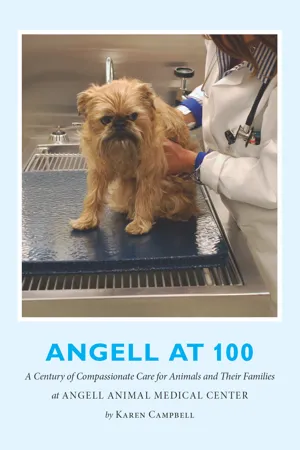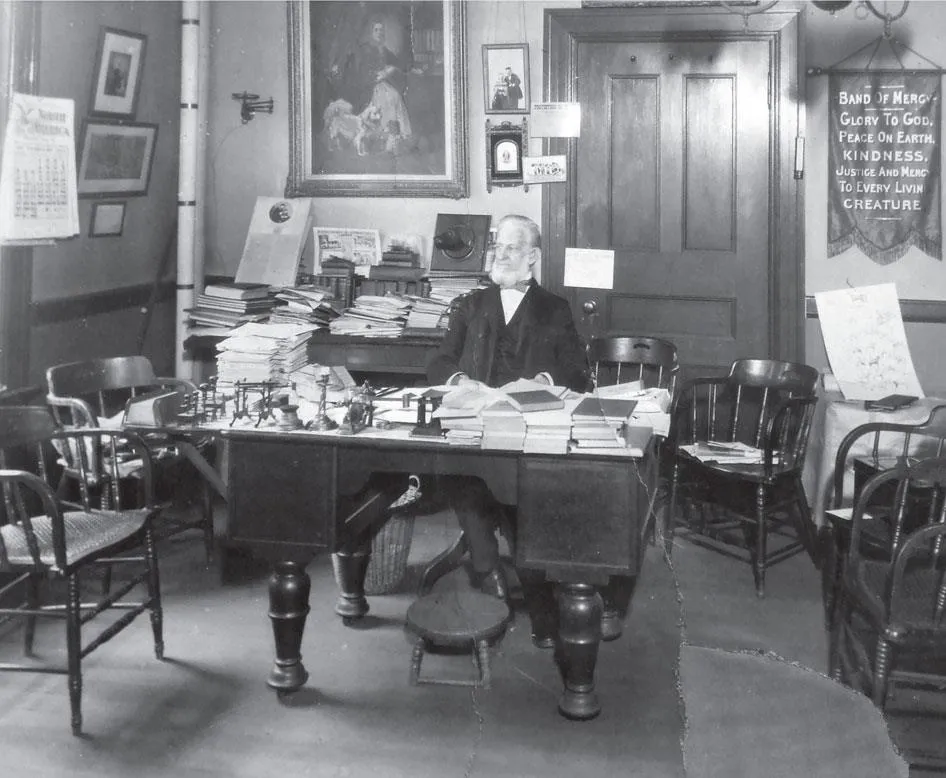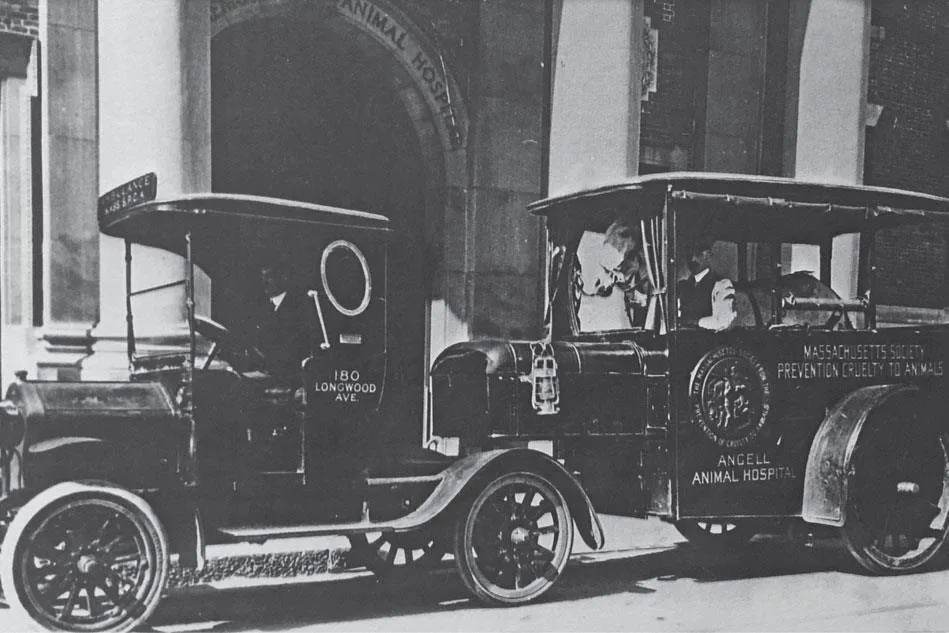CHAPTER 1
George Thorndike Angell: “Working at the Roots”
GEORGE THORNDIKE ANGELL (1823–1909) was born in Southbridge, Massachusetts. The son of a schoolteacher and a Baptist minister, young George was a bright, studious boy with a love of animals. He spent much of his boyhood on New England farms, and from an early age, he was known for speaking up if he heard of animals being mistreated.
Early in George’s childhood, his father died, leaving the family penniless. As George’s mother struggled to make their meager ends meet, he often ended up shuffling between a series of relatives, taking on odd jobs as a teenager. Yet he still managed to excel at school. He was accepted at Dartmouth College, where, according to one account, “his pronounced opinions, his sterling character, and his intelligence marked him as a leader.” After graduation, he taught in the Boston public schools and attended Harvard Law School.
After passing the bar, Angell became not only a successful attorney but also a renowned philanthropist and humanitarian, known for his integrity and social commitment. An activist with a keen sense of justice, he worked for child welfare and penal reform, and he was a staunch abolitionist, partnering with antislavery advocate Samuel E. Sewall for fourteen years.
However, the issue closest to Angell’s heart was the welfare of animals, and he became one of America’s foremost pioneers in championing their protection and humane treatment. At that time, the intrinsic worth of animals remained a rarely embraced concept. Animals were still considered as property, primarily valuable only inasmuch as they were useful. As such, they could be treated in any way an owner chose, without interference. In the mid-1800s, conditions were especially bad for city workhorses, who were often overworked, underfed, and driven to the point of exhaustion, as their raw flesh chafed under heavy collars. Their lifespan was usually less than four years.
In 1864, two years before the formation of the first humane society in America, Angell decided to draw up his last will and testament, including these compelling words: “It has long been my opinion that there is much wrong in the treatment of domestic animals . . . and it is my earnest wish to do something towards awakening public sentiment on this subject.” In the document, he stated his desire to donate a considerable portion of his estate toward “circulating in schools, Sunday schools and elsewhere, information calculated to prevent cruelty to Animals.” He noted that he was determined to “plead for the wronged and oppressed, whether they walked on two legs or four.”
Angell then became a leader in the movement’s push for educating children, believing that humanity’s kindness to all creatures could ultimately lead to a more kind and just culture overall. “Every humane publication, every lecture, every step in doing or teaching kindness is a step to prevent crime. . . . Children taught kindness to animals become not only more kind to animals, but to one another.”
Angell’s passion was inflamed in 1868, when he read a newspaper account of an endurance race in which two horses, each pulling two riders, were brutally galloped full speed for more than forty miles over rough terrain, with no rest or water. Both ultimately collapsed; in the guise of sport, the two horses were literally raced to death. Angell was so horrified by the cruelty that he wrote a blistering letter of protest to the Boston Daily Advertiser. The letter caught the attention of a Boston socialite and animal advocate named Emily Appleton, who had hopes of founding an SPCA in Massachusetts similar to one founded in New York by Henry Bergh. With Appleton’s financing and Angell’s legal expertise, the Massachusetts Society for the Prevention of Cruelty to Animals (MSPCA) was launched March 31, 1868, with Angell as the first president, a position he held until his death in 1909.
Within a few short months of the MSPCA’s launch, Angell managed to raise $13,000 and add 1,600 new members to the organization. He drafted and achieved passage of Massachusetts’ first general anticruelty act, and by 1871, similar anticruelty statutes had been enacted in states across the country. Animal protection societies sprang up in twenty-four American cities, and the movement was gaining political traction and increasing public support. Angell also connected with other humane activists in Europe.
From the beginning, Angell cleverly leveraged the cache of some of the organization’s more high-profile enthusiasts, like John Quincy Adams II, Ralph Waldo Emerson, William G. Weld, and Henry Saltonstall. Among the first board members of the organization, they regularly gathered to devise ways of bringing visibility to the cause and paving the way for legislative reform. These powerful movers and shakers helped lay the groundwork for a revolution in how society views and treats animals.
At the core of Angell’s vision was education, with a focus on teaching people of all ages and classes the principles of kindness, compassion, and respect for all life. He believed the future of the movement was in the nation’s children. In 1881, he teamed up with Reverend Thomas Timmins to launch Bands of Mercy, a nationwide network of humane-education youth clubs in which school children pledged to be kind to all living creatures and protect them from abuse. Within two years, there were hundreds of Bands of Mercy across the country, with membership of close to 250,000 girls and boys. By the early twentieth century, there were reportedly more than 27,000 Bands of Mercy.
In 1886, the MSPCA opened its first official headquarters at 19 Milk Street in Boston. Three years later, Angell incorporated the American Humane Education Society (AHES), an organization working in partnership with the MSPCA that was designed “to carry unsectarian humane education gratuitously outside the State of Massachusetts, throughout the country and the continent, and by the employment of suitable agents to establish Bands of Mercy and Humane Societies wherever they are most needed.”
In 1890, Angell published the first American edition of Anna Sewell’s classic Black Beauty, and distributed two million free copies through the Bands of Mercy. Three years later, the AHES distributed the children’s classic Beautiful Joe. Both books persuasively told stories from an animal’s distinctive point of view. Angell himself, having given up the law to devote most of his energies to the cause so dear to his heart, continued his own forms of persuasion. He lobbied tirelessly and passionately, often chastising in print public figures (including Theodore Roosevelt) whom he felt were behaving inhumanely toward animals. Animal rights pioneer Henry Bergh wrote to him: “I have seen you spoken of by the Press here, as ‘an Angell of mercy.’ You are earning the title.”
Toward the end of his life, Angell’s health began to suffer dramatically, yet he continued to work from home, overseeing administrative duties and submitting editorials, dictating one to his secretary just hours before his death. On March 16, 1909, he died peacefully at the age of eighty-five. By the time of his death, Angell had sparked the establishment of more than seventy thousand Bands of Mercy, and according to his New York Times obituary, he was known domestically and abroad as “the friend of animals.”
Thousands lined the streets for Angell’s burial cortege from Boston to Watertown’s Mount Auburn Cemetery. The solemn, affecting procession included thirty-eight workhorses with mourning rosettes on their halters, led by the thirty-five-year-old award-winning workhorse Old Ned.
Three years later, the MSPCA erected the Angell Memorial Fountain in honor of its founder. More than simply commemorative, the fountain reflected Angell’s lifelong ethos; forty-three years earlier, in 1869, Angell had raised funds to build Boston’s very first public drinking fountains, including twenty for animals. Designed by Peabody and Sterns and located in Boston’s Post Office Square, this new memorial’s tall flagstaff, which included a gilded copper eagle on top, arose from a stone basin ringed by lion-head spouts. Each spout of the 1912 Angell Memorial Fountain spewed water into the stone basin for the city’s thirsty, hard-working horses.
CHAPTER 2
The Vision of Dr. Francis H. Rowley
ONE HUNDRED YEARS AGO, the plight of homeless, abandoned, and abused animals was still a rather radical social cause. At the time, the commitment to the humane treatment of animals was primarily geared toward preventing mistreatment, especially to beasts of burden.
An even more innovative idea was the concept of conscientiously promoting animal health as a fundamental component of welfare. That philosophy is at the heart of the MSPCA–Angell. In 1915, the MSPCA opened Angell Memorial Animal Hospital, one of the first veterinary hospitals connected to a humane organization. Its torchbearer was the MSPCA’s second president, Dr. Francis H. Rowley.
After George Angell’s death in 1909, Dr. Francis H. Rowley (1854–1952) was chosen in 1910 to be the MSPCA’s second president, a position he would fill for three and a half decades. In contrast to the fiery, impassioned Angell, with his long silver beard, Rowley was balding and short, with round gold-rimmed glasses and a kindly manner. The father of four, he was the very picture of paternal benevolence.
A gentleman and a scholar, Rowley was a Baptist minister who had served congregations in Pennsylvania and Illinois as well as several in Massachusetts, including the historic First Baptist Church of Boston (1890–1910). Long committed to a number of humanitarian efforts, and an ardent peace advocate, Rowley also served as the secretary and vice president of the American Humane Association and was a director of the Animal Rescue League. Through his many endeavors, he saw firsthand the special joy and comfort animals could bring to their owners, and he backed up his vision with a unique perspective.
While most veterinarians of the day primarily took care of horses, which were still valuable service animals integral to daily life, Rowley had the vision to foresee a need for a center that could treat companion animals. He felt such a center should also be dedicated to furthering the service and science of animal welfare. He explained, “The idea before us is to advance to the limit of our power the whole practice of veterinary medicine and surgery in New England; to set an ever-higher standard, and to assist all members of this important profession in establishing their work on the best possible level.”
Shortly after taking over as the MSPCA’s president, Rowley purchased the organization’s first motorized ambulance to serve horses. (Horses still dominated city streets, including pulling non-motorized ambulances.) Rowley also began pushing for a first-class treatment destination for the ambulance to bring the ailing horses. Noting that a number of animal hospitals had already sprung up abroad as well as in New York City, Rowley pressed for the MSPCA to build its own veterinary hospital in Boston. He wrote, “This is the latest phase of humane work. It is one more step forward. Once it was just to protect the animal from its tormentors. Now, to care for him when sick or injured, if his value to his owner warrants it, is demanded by a deepening sense of what humanity and kindness mean.”
So construction began on the $200,000 brick and limestone building at 180 Longwood Avenue that was to house the MSPCA’s myriad activities as well as a world-class veterinary hospital—all under one roof. Located in the heart of Boston’s medical district, Angell Memorial Animal Hospital opened to invited visitors with great fanfare on February 25, 1915. It was dedicated to George T. Angell, “Apostle of Humanity to Animals,” and its mission was to provide the best medical care for animals and to advance the practice of veterinary medicine. The Boston Post proclaimed, “It is a rare distinction that Boston now has—the possession of the best and largest animal hospital in the world. It is a very appropriate distinction, also, for here has the sentiment of mercy for the creatures that cannot help themselves been effectively fostered for years.”



